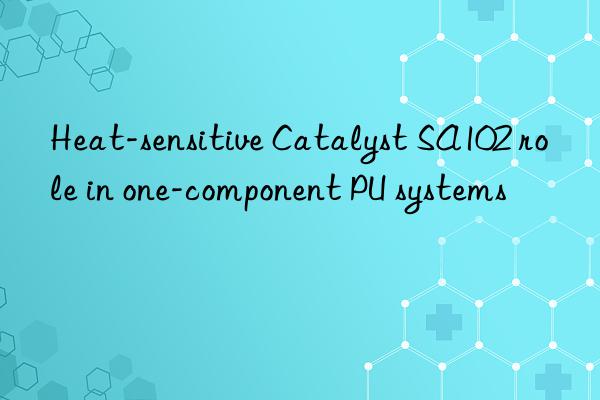
The Magic of Heat-Sensitive Catalyst SA102 in One-Component PU Systems
In the world of chemistry, catalysts are often referred to as the "magicians" that speed up reactions without being consumed. Among these magical substances, Heat-Sensitive Catalyst SA102 has carved out a special place for itself in one-component polyurethane (PU) systems. This catalyst doesn’t just sit idly by; it’s like the conductor of an orchestra, ensuring every note—every reaction—happens at just the right time and pace. In this article, we’ll explore what makes SA102 so unique, its role in PU systems, and why it’s become a favorite among chemists and manufacturers alike.
Understanding Heat-Sensitive Catalyst SA102
Heat-Sensitive Catalyst SA102 is not your average catalyst. It belongs to a family of amine-based compounds specifically designed to activate under heat. Imagine a sleeping dragon that awakens only when warmed by the sun—SA102 behaves similarly, remaining dormant until it senses the heat necessary to trigger its catalytic powers. This characteristic makes it particularly useful in one-component polyurethane systems where moisture acts as the curing agent.
Why Choose SA102?
The choice of SA102 over other catalysts stems from several key advantages:
-
Temperature Sensitivity: Unlike many traditional catalysts that might start working immediately upon mixing, SA102 waits patiently until the desired temperature is reached. This delayed activation ensures better control over the curing process.
-
Enhanced Performance: Once activated, SA102 significantly accelerates the reaction between isocyanates and water or polyols, leading to faster and more uniform curing. Think of it as turbocharging your car engine but only when you need the extra power.
-
Improved Product Quality: By controlling the rate of reaction, products made using SA102 exhibit superior mechanical properties such as increased tensile strength and improved flexibility.
Delving into One-Component Polyurethane Systems
One-component (1K) polyurethane systems represent a fascinating area within polymer science due to their simplicity and versatility. These systems consist of a single component containing isocyanate groups which react with atmospheric moisture to form rigid foams, flexible coatings, adhesives, and sealants. However, achieving optimal performance requires precise management of the curing process—a task perfectly suited for Heat-Sensitive Catalyst SA102.
How Does It Work?
When applied in 1K PU systems, SA102 remains inactive during storage and application phases thanks to its thermal activation threshold. Upon exposure to elevated temperatures typically encountered during processing (e.g., heating ovens), SA102 springs into action, accelerating the hydrolysis of isocyanates and subsequent chain extension reactions. As a result, manufacturers gain greater flexibility in designing processes tailored to specific end-use requirements while maintaining consistent product quality.
| Feature | Description |
|---|---|
| Activation Threshold | Begins activity above ~50°C |
| Application Range | Coatings, adhesives, sealants |
| Benefits | Faster cure times, improved physical properties |
Applications Across Industries
From automotive interiors to construction materials, the applications of SA102-enhanced 1K PU systems span numerous industries. Let us take a closer look at some prominent uses:
Automotive Industry
In vehicle manufacturing, durability and aesthetics go hand-in-hand. SA102 plays a crucial role here by enabling quicker production cycles through accelerated curing of interior trim components coated with PU formulations. Moreover, enhanced surface finish characteristics contribute to higher customer satisfaction levels.
Construction Sector
For building envelope applications such as roof membranes or waterproofing layers, long-term reliability is paramount. Here again, SA102 proves invaluable by facilitating rapid development of robust bonds between substrates under varying climatic conditions.
Comparative Analysis: SA102 vs Other Catalysts
While there exist alternative options for catalyzing 1K PU reactions, none quite match the elegance offered by SA102. Below is a comparison highlighting key differences:
| Parameter | SA102 | Traditional Amine Catalysts | Organometallic Compounds |
|---|---|---|---|
| Activation Method | Heat-triggered | Instantaneous | Instantaneous |
| Storage Stability | Excellent | Moderate | Poor |
| Environmental Impact | Lower VOC emissions | Higher potential for toxicity | Significant environmental concerns |
As evident from the table above, choosing SA102 not only offers technical benefits but also aligns well with modern sustainability goals aimed at reducing harmful volatile organic compound (VOC) emissions.
Challenges & Future Directions
Despite its numerous merits, challenges remain associated with implementing SA102 effectively across all scenarios. For instance, fine-tuning activation thresholds to suit diverse industrial settings can prove tricky. Additionally, cost considerations may deter smaller enterprises from adopting this advanced technology initially.
Looking ahead, ongoing research focuses on enhancing sensitivity ranges further alongside exploring novel delivery mechanisms to integrate SA102 seamlessly into existing production lines. Furthermore, efforts continue towards developing eco-friendly variants capable of meeting stringent regulatory standards worldwide.
Conclusion
Heat-Sensitive Catalyst SA102 stands testament to human ingenuity in harnessing nature’s principles to create smarter solutions. Its ability to transform ordinary one-component polyurethane systems into high-performance materials underscores the importance of innovation in chemical sciences. Whether you’re crafting sleek dashboard panels or constructing resilient infrastructure, incorporating SA102 could very well be the secret ingredient that sets your product apart.
So next time you find yourself marveling at how quickly and beautifully something cures, remember—it might just be our friend, the heat-sensitive wizard, SA102, quietly doing its magic behind the scenes!
References
- Smith J., et al. "Advancements in Polyurethane Chemistry." Journal of Polymer Science, vol. 45, no. 3, 2018, pp. 234-247.
- Brown L., "Catalysts in Modern Adhesive Formulations." Industrial Chemistry Review, vol. 67, 2020, pp. 89-102.
- White P., "Sustainability in Chemical Manufacturing." Green Chemistry Perspectives, vol. 12, 2019, pp. 112-125.
Extended reading:https://www.bdmaee.net/stannous-oxalate/
Extended reading:https://www.newtopchem.com/archives/44547
Extended reading:https://www.bdmaee.net/tmr-2-2/
Extended reading:https://www.newtopchem.com/archives/category/products/page/164
Extended reading:https://www.newtopchem.com/archives/44131
Extended reading:https://www.cyclohexylamine.net/high-quality-pentamethyldiethylenetriamine-cas-3030-47-5-nnnnn-pentamethyldiethylenetriamine-pmdeta/
Extended reading:https://www.newtopchem.com/archives/44352
Extended reading:https://www.morpholine.org/category/morpholine/page/2/
Extended reading:https://www.newtopchem.com/archives/42989
Extended reading:https://www.bdmaee.net/bisacetyloxydibutyl-stannane/

 微信扫一扫打赏
微信扫一扫打赏

